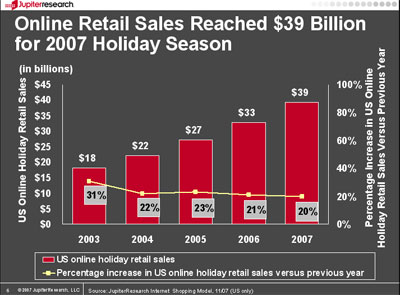I promised more from CJU, and more I shall deliver! This was an informative session, mostly featuring a lot of analytic and numbers supplied by Jupiter Research. The speaker was:
- Patti Freeman-Evans, Research Director & Senior Analyst, Jupiter Research.
Kind of dry, but had some good information.
Bullet Point Review!
- Affiliate marketing will have to change and adapt with the general economic conditions.
- Weak dollar, housing value declining, tighter credit markets, rising retail prices, possible inflation.
- It’s a slow process for consumers to come back.
- Online retailing up 15% in 2008 (estimated).
- Online retail has been doing well, but starting to slow from economic down turn.
- Online buyer much more affluent than offline shopper.
- Online still going up because people don’t want to drive.
- 30% of consumers believe that they can get a better deal online.
- 36% of offline sales are influenced by online research.
- Expected to raise to 50% by 2012.
- 2008 – 6% of total US retail sales made online.
- More people looking for financial services online.
- Online retail sales reached $39 billion for 2007 holidays.
- Many CEO’s of multichannel retailers looking for growth.
- Expect a lot of free shipping offers, discounts, coupons, etc.
- Increase in number of people looking for free shipping online.
- Worth looking at ROI, but doesn’t necessarily create incremental sales.
- Harder to turn that free shipping/discount customer into a full price customer later on.
- Online ad spend is 1/10 of total ad spend.
- Printed ads are lagging in performance and are expensive.
- Merchants are looking for cost-effective alternatives in advertising.
- The pace of display ad growth is faster than, but no bigger than, search.
- Mostly due to advancements in targeting.
- Better value for the money.
- Seeing growth in new media experimentation.
- Advertisers prepare for rich media & video, less static banners & text.
- Affiliates are the ones taking the risk on the sale.
- 13% compound annual growth rate – $2.1 billion.
- Affiliate industry is growing at ~9%.
- Publishers need to be relevant!
- Never underestimate the ignorance of the government regarding the internet.
- Other states are looking at the NY Tax issue and to the online area for taxation over the next 18 months.
- By 2012, 51% of online shoppers will be female.
- By 2012, 56% will be over the age of 35.
- By 2012, 41% will have an annual income of $75k+.
- By 2012, 69% will be Caucasian.
- Now – online shoppers are affluent & Caucasian, split evenly between male and female.
- Don’t concern yourself too much about other languages now as most online shopping is done by English speaking individuals.
- Consumers are making fewer decisions before getting online to buy.
- Only 31% known the item they want before hand.
- Search in research process has grown.
- Fundamentally, social media is influencing decisions by way of reviews, but otherwise not having a large effect.
- Consumers are more likely to start the buying process at the retail site they want to purchase from.
- Over time there could be a paradigm shift to social media.
- Online buyers go to three sites on average during the buying process.
- Google increases solidifies it’s dominant position as top traffic source for most retail sites.
- Why do people go to other sites?
- 71% : To see other prices
- 41%: Like to shop around
- 29%: Looking for free shipping
- 29%: Looking for more product information
- 23%: To get a sense of what other people said about the product
- 23%: To check other sites offers
- 23%: To see expert reviews
- 21%: To validate product information already found
- Put what the people are searching for on your site so they don’t have to leave (i.e. include reviews, comparison pricing, product info, etc).
- Consumers trust reviews, spend more on those products, and become loyal.
- 69%: Impulse buyers
- 60%: Brand advocates
- 60%: Loyalist
- 52%: Directed buyers
- 48%: Overall online users
- Learn from reviews to create communication strategy.
- On average consumers come back to the site 2.5 times.
- About 20% of online retailers include “Recently viewed products” to try to cross sell other things the consumer already looked at (Amazon is the best example).
- Loyalists are not as profitable as customers (they’re just as likely to abandon in favor of a lower price).
- Use direct customer input to set achievable buyer expectations.
- About 60% of online retailers have persistent carts (i.e. when you leave the site & come back, the items are still in your cart or gives you the option to save items for a later purchase).
- The sooner you can give the customer information on incidental feels (shipping, handling, processing, etc) the better.
There was no time for any questions from the audience because it was so JAM PACKED with data and information. Every slide Patti shared had great graphics, which was kind of hard to concentrate on, but great for any data and analytic nuts that want to see concrete research represented in lovely chart format. I know this definitely inspired me to learn more about perfecting charts within Excel! Great stuff overall for affiliate managers and online marketers alike.
One Comment
Join the conversation and post a comment.


Advertisers prepare for rich media & video, less static banners & text.
Affiliates are the ones taking the risk on the sale.13% compound annual growth rate – $2.1 billion. Affiliate industry is growing at ~9%.